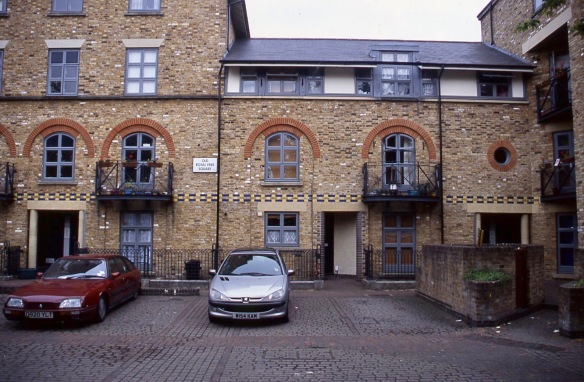Here are the pictures that I scanned yesterday from my Streets of London series of July 2005:
Percy Circus WC1 remains a tribute to 19th Century town planning and 20th Century restoration.
https://www.locallocalhistory.co.uk/municipal-housing/percy/index.htm offers this description: ‘The whole area was set out on a south-facing hillside, in classical layouts; a Circus, Squares and numerous Rectangles. It was a planned as a Classical estate layout, designed to be near the City of London but away from its old crowded houses. It could have come directly from some 18th Century architect’s notebook when he returned from the Grand Tour. It was completely different from the traditional City of London layout. There the streets were narrow lanes. Here roads wer generously wide and laid out as vistas. Houses were large and impressive, not the narrow fronted, tall houses squeezed upwards by the old City walls.
The people who first moved into these houses had ‘arrived’. They were the successful ones and could now enjoy the new, spacious houses. It was exactly like the contrast between the tenements of Old Edinburgh and Edinburgh New Town, laid out on its Classical grid.
The air was better in Percy Circus than in the City of London, but it was near King’s Cross and Euston and would not be free of soot for another century and the Clean Air Acts of 1956, 1968 and 1990.
The houses were built as separate properties and some remained like this, but soon many were divided into floors and even separate rooms. Decades before 1939 and the Second World War, in it had become a densely packed area, full of bed-sitting rooms and single women. Their potential husbands had been killed in the First World War. The most relevant novel seems to me to be Riceyman Steps by Arnold Bennett, which is set nearby.’
This very informative site provides historic maps and photographic descriptions of the restoration carried out following the destruction brought about by numerous bombings in the second world war.
Down the hill we arrive at Vernon Square, the early residents of which would be amazed at the traffic congestion encountered on Penton Rise,
which joins Kings Cross Road. Following the BBC television series ‘The Urban Chef’ of 2006, The Prince Albert, at the corner of Acton Street, has become a thriving gastropub.
Frederick Street WC1 lies parallel to Acton Street. You could buy one of these houses for £2.5 million give or take a grand or two.
On a level with Percy Circus stands Lloyd Street, part of the Lloyd Baker estate where I once lived and which has featured a number of times in this series.
Islington’s Chapel Market N1 is still a bustling, colourful, source of stall-holders’ produce. Fosby’s Café, on the corner of White Conduit Street, was a popular eating place. It seems now to be no longer in business.
In Grant Street a fruiterer sets out his oranges over which are suspended string bags of garlic.
Clothes and books are on offer in North West Place.
The fruit on the Baron Street stall remains as fresh as it was when sampled yesterday. As far as I can tell, the bar with the beautiful floral display is the Alma which has been recently updated.
Tolpuddle Street N1 lies parallel to Chapel Street. The Angelic, with its address in Liverpool Road, is a popular gastro-pub.
Hemingford Road N1 is situated between Caledonian Road and Liverpool Road,
to the east of which, Moon Street is an attractive little cul-de-sac.
In a short while Jackie will be driving me to New Hall Hospital for my first post-discharge physiotherapy session. I will report on that tomorrow.
























